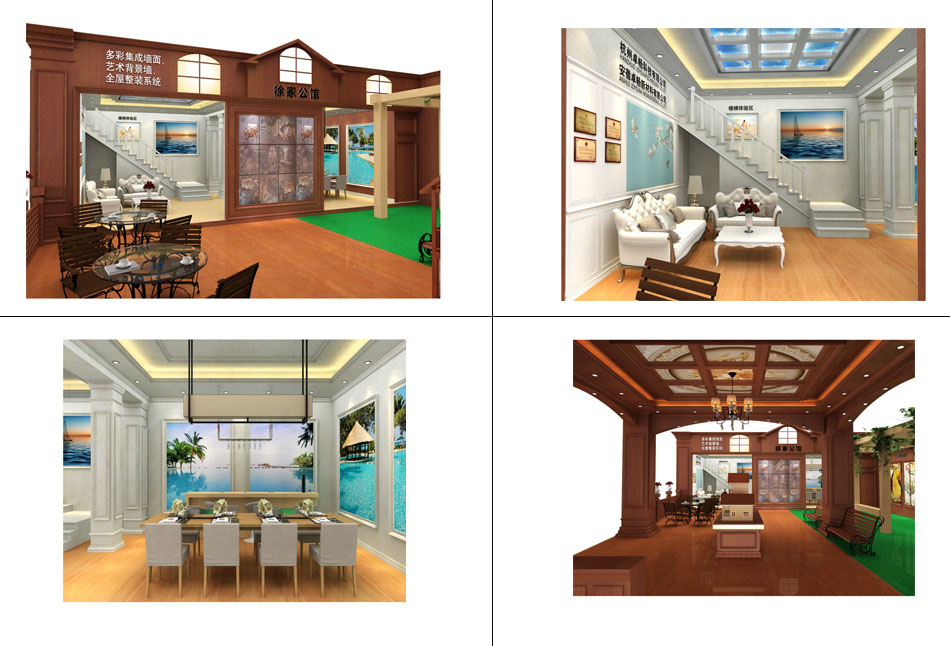By optimizing the image and focusing on the case, the company's exhibition hall gains the trust of visiting customers, allowing customers to understand the culture, product range, quality and other aspects of the company, thus taking advantage of the competition. In recent years, companies have built their own showrooms.
1, pay more attention to the creation of features. Since most of the corporate exhibition halls and enterprise product showrooms are indoors, the indoor space is generally rectangular, semi-arc type, and the mixed load-bearing columns are in close proximity. Therefore, many corporate exhibition halls look "very like". In fact, each company has its own characteristics and highlights. As long as it is carefully studied and designed, it will be able to design a colorful corporate showroom.
2, pay more attention to the application of materials. Different from the exhibition design, the corporate exhibition halls and showrooms are indoors and fixed for a long time, so there are many construction materials to choose from. Unlike the exhibition space, you can only choose some simple finishes. There are more and more new materials on the market, so the rational and creative application materials have greatly affected the overall effect.
3. Pay more attention to the participation of the audience. Many corporate exhibition halls take out the pictures of the company and display the mechanical machinery in the window. After taking a customer around the exhibition hall, the impression left by the customer is relatively simple.
Display is an important means of conveying and exchanging information in modern society. As the scale of the exhibition continues to expand, the business information injected by the company is also exponentially increasing. In addition to showing the competitive strength, the large-scale display often makes the publicity effect unforgettable. For exhibition designers, large-scale displays are an extraordinary challenge.
The theme and style of the exhibition is the basis of the overall design of the exhibition and the origin of the exhibition design. An exhibition, artistic, scientific, trade, design and implementation of voluminous affairs, the same military battle, a band performance, a drama performance and a film production, if there is no exhibition overall Design, unified planning and command is unthinkable. It is also unthinkable if the overall designer of the exhibition cannot grasp the theme and style of the exhibition. Display design is not only a comprehensive art with multiple scientific intersections, but also a practical and practical practical subject. It is a systematic project, and its design method is not a patchwork, it can be effective. In order to maintain the integrity and continuity of its functional design, the diversity of forms and the unity of style, the theme and style of the exhibition must be established in advance at the beginning of the exhibition design. It is especially important in the design process of large-scale exhibitions. It is necessary to take care of the left and right and the response before and after, to ensure that the theme of the exhibition design is outstanding and the style is unified.
How to create a framework for displaying the theme and style is the key to display design. It determines the direction of the design. The design concept must be based on a certain theme. In the early stages of design, it is necessary to grasp the intent, goals, and information to be communicated to the organizers and exhibitors, and thus determine the general framework of the theme and style of the show. A good display theme must be able to directly express the content of the exhibition, and can create a special exhibition atmosphere to effectively attract customers to achieve the purpose of marketing. Secondly, we should divide the small themes that complement the big theme, as well as related projects. These contents must be subject to the overall style, but also have unique ideas, which can become a wonderful local point. These wonderful points are coordinated with the overall style, which becomes the framework for displaying the theme and style. Starting from this, consider the layout of the space and the arrangement of the structure and start the basic design.
In addition to the schematic diagram of each project, the relationship between the small themes should also be the focus of attention. With the progress of the design work and the investigation of the relevant information of the enterprise, the various small themes to be displayed should be drawn up accordingly. The display design is influenced by the theme and style of the exhibition from beginning to end, and the relationship between the theme of the small theme and the style of the display space are also closely related. Once the framework for displaying the theme and style is decided, it is necessary to discuss the information content of each project that constitutes each topic, but it must be discussed based on the overall style of the display theme, and establish the focus of the display, divide the display area and the spatial and structural relationship, Styling details, etc.
The business information conveyed in the exhibition design will eventually be implemented in various display media such as models, images, charts and samples. The distribution of all these display media must also be determined according to the content of the display. Focus on the presentation of important topics. It takes a lot of imagination to create a variety of novel propaganda media, and the use of innovative media to express the focus of the show can often produce unexpected results. Discuss and choose specific solutions that make these ideas workable, ensuring that they meet the limits of the exhibition venue and have a uniform style.
The basic design plan and implementation plan must have an adjustment process as the design and production operations are carried out. Especially in the implementation stage of the design, the details of the design and the information content of the development have been finalized, but sometimes the design must be modified due to changes in site conditions and information materials. In this case, the origin of the return is often the theme and style of the show, so the display of the theme and style is a very important key to large-scale display design.
What is the measure of success in large-scale display design? One sees whether the theme is outstanding; the other looks at whether the style is unique. If a large display theme is unknown, it can only be regarded as a market trade. If there is a theme but it is not prominent, it will not leave a deep impression. If the theme is outstanding, but the style is dull and the style is common, then there is no recollection.
The style of large-scale display design is built on the deep cultural heritage. To form an unprecedented unique style, we must explore the cultural characteristics of the exhibition place and the cultural background of the exhibits, whether it is lighting, color, music, pictures, exhibits. The quality of the design and service personnel is linked to the highlights of the cultural background. In these intricate connections, a common fulcrum is sought, and a unique style will emerge.
The materialization of the large display design is to achieve the best product display effect. The display design is not only artistic and functional, but we should also pay attention to its commercial characteristics. Its commerciality is far greater than other characteristics, in a sense it is an extension of the enterprise goods. The amount of commercial information injected in the large-scale display design and the quality of the products directly affect the success of the organizers and enterprises. Conceptual display of the theme and style enables the designer to fully and accurately grasp all the information of the company and the goods, effectively mobilize all means of display art, and provide strong support and help for the exhibitors to seize market opportunities and establish a good image.

 Scan and follow the official WeChat
Scan and follow the official WeChat
 Sweep into the WeChat applet
Sweep into the WeChat applet

 National unified hotline:13710467636
National unified hotline:13710467636






